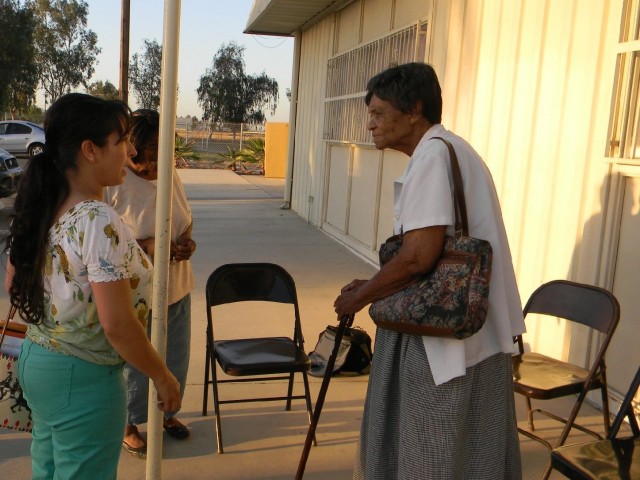“It was a lot of labor camps, they call them,” said Carrie Bonner, a Lanare resident still tall and strong at 89. “Cotton chopping, picking and cutting grapes. … Whatever season it was, that’s what they would do.”
Lanare was once a series of shacks for African-American farmworkers, Bonner says. Her father-in-law ran a juke joint not far from here and was a labor contractor.
She said when she first moved to Lanare in the 1950s, there were very few farmworkers who came from Mexico. But as time went on, the population changed. “Now it’s just a few blacks and more Spanish, you know,” she said.
Water lines arrived in the 70s -- but drinkable water didn't last
In the 1970s, a Quaker organization helped the people of Lanare build houses and put in water lines. Bonner was one of the first to move into a new home, the one she still lives in today. But she and others stopped drinking the tap water years ago because it has high levels of arsenic.
In 2002, the town got some federal grant money to clean the water. “The county allocated it, 1.3 million dollars,” said Veronica Garibay of the Leadership Council for Justice and Accountability.
The town used the money to build a water treatment facility in 2006. But there was trouble from the start. Fresno county rubber-stamped the federally funded plant without an adequate cost analysis, said Garibay. It’s expensive to treat arsenic, and costs spiraled beyond what the community could manage. The town had no water meters to track residents’ usage. And some of the pricey filtered water was unintentionally going to irrigate fields. On top of that, the local water district lacked financial and technical expertise.
“A board of five volunteers from the community without any background in water operation or maintenance are running a treatment plant,” said Garibay.
Lanare couldn’t afford to run it, and the state shut down the plant after just six months. Now the town’s water system is operated by a private company or receiver. Residents pay a monthly bill for running water –- but they still can’t drink it. Instead, many spend $20 to $30 more each month for bottled water. That’s not uncommon in the valley where hundreds more small water districts have problems with pollutants, including nitrates and selenium.
"Who gets control of the good water?"
“It’s a really complicated story,” said John Capitman, a public policy expert at Fresno State University. “It may be the farming practices of somebody 20 miles away 20 years ago that spoiled the water that your well draws on. So this is something about a long term process of connected aquifers underneath the ground, pumping, history, exploitation. Who gets the control of the good water? It plays out all over the region.”
These small, volunteer water districts not only lack the political clout, but also technical and financial wherewithal, he says. “The patience to make it through crazy bureaucratic systems,” he added.
And there’s a catch when it comes to technical and financial expertise.
“Those capabilities are also federal requirements in order to get funding,” said Mark Starr, deputy director of the Center for Environmental Health at the California Department of Public Health. His agency is charged with helping these communities comply with the Safe Drinking Water Act.
Millions for water improvements left unspent
But last spring, the EPA scolded the Department of Public Health for failing to spend hundreds of millions of dollars for water improvements. The state said it is working harder to move the funds more quickly and provide more technical assistance.
Lanare recently got grants to take steps toward a permanent solution, said Starr. The grants “were used to install water meters, a project that’s underway -- and also educate Lanare residents about conservation.”
A study to explore solutions for Lanare will be completed by June, said Starr. These options include digging a new well, restarting the old treatment plant and hooking into a nearby town’s water treatment facility.
Back at the community center, Isabel Solorio said she knows the town is poor and treating tainted water is expensive. But she and other residents won’t quit pushing for clean water.
“It’s a lot of work, but you know what? I am so happy when I see part of my community here and tell everybody ‘come on let’s go working together,’” she said. “Because this is your community.”
